
 |
|
|
|

2012 is seeing a fresh crop of Blu-ray releases of unexpectedly good quality. Kino/Redemption has just come out with a pair of English horror pictures mastered from original materials so good that fans may not immediately recognize them. Neither title can boast a top-level reputation, but one stars the horror icon Peter Cushing, and the other is presented in an original uncensored version. Both were directed by Vernon Sewell, a veteran British director who seems to have had little affinity for screen horror. Back in the 1940s, the Archers (Michael Powell & Emeric Pressburger) thought so highly of Sewell that they entrusted him with their (highly recommended) wartime production The Silver Fleet. The lesser of the two films is 1968's The Blood Beast Terror, a curiously thrill-challenged monster story that revisits well-trod Hammer territory. It was distributed by Tigon British Films, which made horror films with the cult director Michael Reeves (Witchfinder General) and contributed other interesting alternatives to Hammer, like The Blood on Satan's Claw (Piers Haggard) and Doomwatch (Peter Sasdy). Executive producer Tony Tenser also gave Roman Polanski his first shot at an English-language film, 1965's Repulsion. Former camera operator Peter Bryan wrote a couple of classic Hammer pictures, of which The Blood Beast Terror comes off as a poor imitation. Inspector Quennell (Peter Cushing) investigates a string of corpses with their throats torn out, and asks Doctor Carl Mallinger (Robert Flemying of The Horrible Dr. Hichcock) to help him identify little transparent scales left at the murder sites. As it turns out, Mallinger has managed to create a super-moth creature. When disguised in human form the creature masquerades as his daughter, Clare (Wanda Ventham). The twisted Doctor Mallinger is perfecting a mate for Clare but needs human blood to keep it alive. Clare kills several men; Mallinger disappears just as Quennell is narrowing his suspicious eye on him, leaving behind an empty house and a dead servant. Tracing Mallinger to a town in the North Country, Quennell brings his own daughter Meg (Vanessa Howard) along as protective cover. They meet a young entomological student, William (David Griffin), who introduces Quennell to evidence pointing to a large moth-like creature as the killer. In a nearby country house, Mallinger's new hybrid creature rests in cocoon form. To keep it alive, the Doctor hypnotizes young Meg into returning every day, to submit to a blood transfer. 
The Blood Beast Terror is colorful and loud but in dire need of a script revision. Even with its unpromising plotline a stylish director might have been able to make something of it. Although the actors are certainly sincere (and Cushing, predictably, excellent) the show has no pace and seems far slower than its 87 minutes. Scenes are introduced just for padding, as with at least three minutes expended on watching a "funny" morgue attendant (Roy Hudd) prepare his lunch among the corpses. An amateur theatrical presentation in Mallinger's house reminds us of The Castle of the Living Dead but is carried off without any finesse whatsoever - burning up at least six minutes of screen time. The last straw, script-wise, occurs when Quennell solves the mystery. Instead of wrapping things up, the movie then relocates to a rural setting where Quennell must start from scratch, introducing new characters. The monster itself is not well explained. Dr. Mallinger is trying to breed a new race of moth-people, much like the original Baron Frankenstein. Why he turns his daughter into a moth (or is she a moth turned into a daughter?) is a mystery. Poor story construction gives us five minutes of an irrelevant fishing scene, but then chooses to completely skip the rather important kidnapping of young Meg. A cut from Clare picking Meg up on the road jumps to the middle of a transfusion scene, with Meg's blood being pumped into the new moth-cocoon. It stands in the background like an old ironing board. Dr. Mallinger is also an accomplished hypnotist, it seems, but that detail gets no emphasis whatsoever. 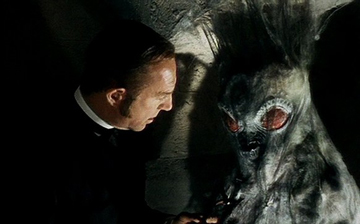
We've gotten a couple of good looks at Wanda Ventham in her flying moth monster form -- she looks more or less like Roger Corman's The Wasp Woman, but with illuminated red eyes. If that's not enough, the film's conclusion is unintentionally funny. All that Peter Cushing's Inspector need do to lure her to her doom is to light a small bonfire. The show doesn't have anything resembling a sense of humor, but I can readily imagine audiences making sarcastic jokes about Bug Zappers. Redemption/Kino's separately sold Blu-ray of The Blood Beast Terror is a quality piece of goods. I once gave up on watching this show on a terrible old VHS tape. This HD transfer appears to come from original materials in perfect condition. The attractive picture shows most of the scenes to be indifferently staged, with flat lighting; don't expect any particular visual excitement beyond the excellent image quality. That brings up another point... HD transfers of films from original elements are giving us a new look at old movies lucky enough to be carefully mastered. As any release print was likely a generation or two removed from a prime element, a show like The Blood Beast Terror looks far better on Blu-ray than original first answer prints. Video scanning sees more color detail and can pull out better contrast than that seen on an average release print from the 1960s. We can see things probably lost on traditional film, like a big microphone shadow that follows Wanda Ventham down a staircase in her introductory scene. 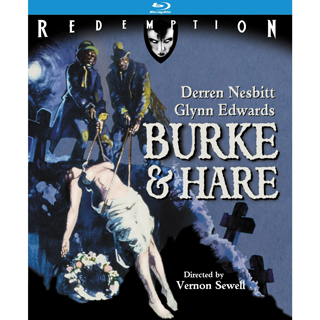
Released in 1972, Burke and Hare is a more ambitious horror project. It tries to update the classic Stevenson "Body Snatchers" tale but spins off in an odd direction, mixing comedy with standard drama and never finding an acceptable tone. Redemption's uncut version retains at least ten minutes of bawdy nude scenes in a sporting house that seem a desperate attempt to enliven the grim story with a graft from the silly spoof The Best House in London (1969). Despite some very good performances, the show comes off as a pointless remake of John Gilling's vastly superior 1959 thriller The Flesh and the Fiends, which starred Peter Cushing. Burke and Hare's identity confusion begins right at the top, with a rock 'n' roll song heard behind the main titles. The show can boast a fine pair of performances. Derren Nesbitt (Where Eagles Dare) and Glynn Edwards (just seen as a Police Sergeant in The Blood Beast Terror) begin smothering sick old men and various paupers on the Edinburgh streets, in order to sell their corpses. The cash 'n' carry buyer is the "anatomist" Dr. Knox (Harry Andrews), who needs them for dissection lessons in his medical school. Together with their greedy wives (Yootha Joyce of Die! Die! My Darling!), the body snatchers grow more bold in their murders; Burke justifies his sudden wealth to a bartender by claiming that he's come into an inheritance. 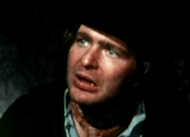
Just as in earlier film versions, Dr. Knox's young medical students frequent a local brothel, where Alan Tucker (James Arbithnot) meets and falls in love with prostitute Marie (François Pascal of The Iron Rose). Burke eventually meets up with Marie and her fellow sex worker Janet (Yutte Stensgaard of Lust for a Vampire), with tragic results. Despite the impressive cast list, Nesbitt and Edwards are the only actors with satisfactory parts to play. Nesbitt in particular is amusing as an impoverished cobbler introduced to a new way of earning quick cash. Unlike earlier versions of the story, little tension is generated, as Dr. Knox's functionaries accept every body in any condition, even those rather obviously murdered. Harry Andrews plays Dr. Knox with an eye patch (a surgeon without stereoscopic vision?) and makes little of the doctor's scripted inconsistencies. Knox strongly disapproves of young Angus' visits to the brothel on moral grounds, but recites an infantile dirty joke for the benefit of his medical cohorts. Knox is perfectly aware that he's receiving tainted specimens, but prefers to ignore the fact. As the local police more or less know what is going on, Knox's symbiotic relationship with the local resurrectionists is tolerated so long as only ones to disappear off the streets are the poor and indigent. Unlike earlier versions of the story, very little is made of this, and the show concludes before the Big Heat comes down on the scandal. 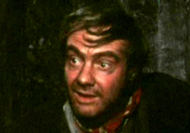
Shoved into the story is a gaudy sidebar story of life at the house of prostitution, complete with 'naughty' scenes of guests invited to look through peepholes. The Madame (Joan Carol) makes the rounds of peepholes as well, affording us glimpses of tame sex games going on in the rooms. The beautiful actresses are displayed as if in a cheap fantasy photo layout from Playboy magazine. The silly brothel scenes nullify destroy the believable detail built up with the foolish body snatchers, and that anachronistic title tune does the rest. When hard times came for the British film industry, Hammer films threw away its special identity by indulging in content that undercut the horror and made their product suitable mainly for dirty old men. Tigon makes the same mistake. 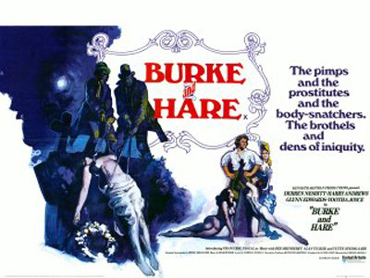
Redemption and Kino's separately sold Blu-ray of Burke and Hare is in equally excellent shape. This show, director Sewell's last feature, has better art direction and (away from the brothel) much better lighting, so there's more to appreciate in the exacting transfer. The Blood Beast Terror offers only a trailer as an extra, while this disc comes with a trailer plus two short interview pieces. Actress François Pascal returns for another interview, but has almost nothing to say about Burke and Hare. We still prefer her company to that of Dr. Patricia MacCormack, a genuine film academic who sports Goth attire and a prominent Lucio Fulci tattoo. Ms. MacCormack dispenses a few facts about Edinburgh body snatching that could be gleaned from a viewing of Burke and Hare, and then proceeds to ramble on fairly incoherently about vampires, Frankenstein and morbidity in culture and movies. The interview is punctuated with mostly unmotivated gory images that include unnecessarily strong stills from Jörg Buttgereit, an auteur whose work shouldn't be sprung unexpected on audiences. Redemption is doing excellent work, bringing out hyper-quality horror Blu-rays. Committed genre fans will probably want to see these two releases just to admire the perfect transfer presentations.
On a scale of Excellent, Good, Fair, and Poor, the separate releases Footnote: 1. A helpful versions comparison note from correspondent Tim Rogerson, 8.13.2012: Hi Glenn ... I Finally compared the Redemption DVD of The Blood Beast Terror with my UK DD Video DVD (I believe the US Image DVD is identical to the UK DD DVD). As generally suspected the major difference is the scene with the Frankenstein play, which is much much longer in the new DVD. Redemption (US) DVD runs 87m 28s (ignoring Redemption ident and a DVD credit after the credits) DD Video UK DVD runs 77m 11s (ignoring Peacemaker Films ident). NTSC adjusted that is 80m 23s. Therefore, a total difference of 7m 5s approx consisting of: Redemption timings: (a) 15m 51s to 16m 20s - 29s of the morgue attendant walking back after closing the door, asking a corpse if he is nice and cosy and then settling down to finish his lunch. (b) 30m 00s - 33m 38s - 3m 38s cut removing the beginning of the staged Frankenstein play. The DD Video print starts with a corpse already on the table with a raised arm missing all the previous stuff involving the organ on the table and the 2 graverobbers bringing in the corpse and having a long (too too long) discussion with Frankenstein which reveals that they probably murdered the dead guy. (c) 36m 45s to 37m 27s - 42s cut after Wanda Ventham has gone up the stairs. Mallender and the butler see the young botanist leave, the butler follows and then Mallender starts a discussion with the writer of the play about Galvinism (dialogue mentions using a Wimhurst device that we later see in the cellar). (d) 38m 58s to 39m 52s - 54s cut removing footage of the botanist looking for Claire in the woods immediately prior to his murder after she has left him for some 'hide & seek'. We hear her off-screen voice enticing him "This way". In the DD version, Claire goes off to play hide & seek, we cut to the Inspector and then abruptly cut back to the botanist who is immediately attacked by the monster (with the implication he was attacked where she had left him). (e) 60m 18s to 61m 40s - 1m 22s cut removing an entire scene set on a river bank in which Peter Cushing and his daughter go up to the father of the boy who collects butterflies who is fishing. Cushing says he'll stay fishing with the father while the daughter says she'll go off and pick berries and the father says she might run into his son who is looking for butterflies. The DD version omits this scene and cuts straight from the previous night to a shot of the boy looking for butterflies. Total 7m 05s. All pretty inconsequential. The material doesn't deal with the two major flaws of the film (other than the monster's pathetic appearance). 1. - What on earth is Mallender's motivation? What exactly has he created and why, let alone how, since he seems to be simply trying to create a monster moth rather than a human/moth hybrid. The revelation that Claire is his 'creation' rather than his daughter is a throwaway line right at the end which is not pursued. 2. Why does the inspector feel that he hasn't got enough evidence against Mallender when he's found loads of corpses at his house. Why does he spend his time fishing and reading books rather than looking for Mallender?! Regards, Tim Rogerson
Reviews on the Savant main site have additional credits information and are often updated and annotated with reader input and graphics. Also, don't forget the 2011 Savant Wish List. T'was Ever Thus.
Review Staff | About DVD Talk | Newsletter Subscribe | Join DVD Talk Forum |
| ||||||||||||||||||